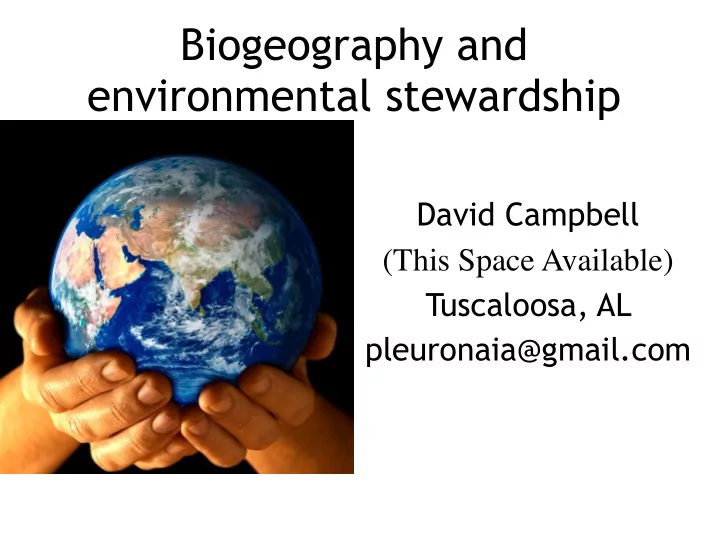

Biogeography and environmental stewardship David Campbell (This Space Available) Tuscaloosa, AL pleuronaia@gmail.com
• A Christian understanding of the universe as God’s creation, reflecting His wisdom, power, and glory, provides a solid reason for environmental stewardship. • To fulfill the mandate of Gen. 1:26 to rule the earth, in light of other passages on godly ruling, we must understand how the earth works. • Implementing this stewardship through effective environmental policy requires using the best available science to determine needs and how to address them.
• Conservation needs for freshwater habitats (among others) are particularly acute – high diversity, high endemism, high human impact • How to prioritize? – Which populations are actual rare species as opposed to mere local variants? • Understanding the means of creation helps identify unstudied populations likely to be species of concern. In particular, geologic history and evolution provide clues to likely biogeographic patterns.
What’s wrong with this picture? Souvenir of Florida
What’s wrong with this picture? MY SAFARI
Both Darwin and Wallace’s ideas of evolution were strongly influenced by their observations of biogeographic patterns
Biogeography • More isolated areas have greater difference (remembering that isolation changes over geologic time-different patterns in fossils) • Holds true at many scales (Australia unique; different snails and clams from one river to the next) for any barrier • Makes sense if organisms created by evolving from whatever ancestors reached the area and survived
Antievolutionary claim that Australian marsupials are the only example of macrobiogeography • Attacking the textbook - it’s the textbook example because most people don’t know enough about non-mammals to be familiar with any other, not because no others exist-about 40 come to mind for me without looking things up – Notably, almost every type of native terrestrial or freshwater organism in Australia is also distinctive • Claimed that marsupial example is invalid because of opossums in America-but those are a very different group of marsupials from Australian ones, and the diverse South American fossil record (before connection with North America) had many additional unique marsupials and other organisms ; up to Eocene South America and Australia were connected and marsupials were still present on other continents
Biogeography and the Bible • “your servant has killed both lion and bear” I Sam. 17:36. Lions and bears lived in Palestine in David’s day. • In contrast, in the Book of Mormon, “both the cow and the ox, and the ass and the horse, and the goat and the wild goat” (I Nephi 18:25) is entirely wrong.
Biogeography and Conservation • At a global scale, isolated areas are especially rich in endemics – Australia, Madagascar, Hawaii • Importance for local conservation planning often underappreciated • Isolation may reflect cryptic speciation. • Isolated or marginal populations are likely to be genetically distinctive and important to conserve for future evolutionary resilience
Elliptio crassidens Mussels-by river Plethobasus cyphus Hemistena lata Elliptio dilatata "Pleurobema" collina Fusconaia cerina Fusconaia flava Quincuncina burkei Fusconaia subrotunda Pleurobema beadlianum Pleurobema perovatum Pleurobema taitanum Pleurobema furvum Pleurobema rubellum Pleurobema strodeanum Pleurobema chattanoogaense Pleurobema decisum Pleurobema hanleyianum Pleurobema troschelianum Pleurobema georgianum Pleurobema pyriforme Pleurobema clava Pleurobema oviforme Sintoxia cordatum Sintoxia rubrum Sintoxia sintoxia Pleuronaia barnesiana Pleuronaia dollabelloides Pleuronaia gibberum “Pleurobema” stabile Mollusks not generally good dispersers
Despite the different shapes, the top three are closely related and all occur in the Coosa River system
Juga-isolation, Pleistocene Excerpted from figures drawn by Ed Johannes
Several new species identified by our analyses Perhaps this one could be called the little brown juga.
Campeloma-confusion
Pomacea paludosa Miami South Asia, Australia Africa Viviparida eGlobal East Asia patterns North America Europe North America North America
Angulyagra sp Vietnam Taia polyzonata 1 Larina sp Bellamya bengalensis 1 Bellamya capillata 4 Bellamya jeffreysi 1 Bellamya jeffreysi 2 Neothauma tanganyicense 1 Bellamya capillata 2 Bellamya sp 2 Victoria Bellamya trochlearis 2 Bellamya unicolor 1 Morphology confusion Bellamya rubicunda 2 Bellamya unicolor elatior 4 Bellamya sp 1 Victoria Bellamya sp 5 Cipangopaludina chinensis MI (invasive) Viviparidae sp 2 China Cipangopaludina japonica 1 Viviparidae sp 1 China Bellamya sp China Mekongia sp 1 Sinotaia sp 1 Tulotoma magnifica Selma2 Viviparus georgianus Talquin Viviparus georgianus Wheeler Viviparus georgianus Palm Beach Co FL Viviparus subpurpureus TN Viviparus ater Viviparus contectus
Campeloma regulare east AL Hybrids Campeloma floridense east FL Campeloma decisum NJ and side Campeloma decisum IL Mobile Basin Campeloma decisum MS routes Campeloma regulare central AL Campleoma decisum MI two alleles Campeloma decisum TN* Mitochondria, nuclear Campeloma regulare west AL Campeloma geniculum northwest FL Campeloma decampi Beaverdam Campleoma geniculum northwest FL Campeloma decampi Cedar Ck Campeloma decampi, decisum Limestone+Tenn R* Campeloma decampi Limestone Campeloma decampi Piney North Alabama Campeloma Indian Creek C Campeloma decisum Flint1 Campeloma decisum Flint4 Campeloma Indian Ck A Campeloma Indian Creek F
Recommendations and conclusions • The current species-by-species approach to endangered species protection by the U.S. government does not always protect key habitats • Species-by-species approaches do not highlight critical regional centers of diversity. – Coosa, Clinch, Conasauga • Current approach of listing species groups is useful, but designation of imperiled habitats may be needed • Evolution and historical geology provide important information for caring for creation.
Acknowledgements • Terry Frest, Stephanie Clark, Ed Johannes, and Chuck Lydeard- colleagues on Juga • Paul Johnson, Jim Williams, Andy Rindsberg, Jeanne Serb, Kory Small, and Chuck Lydeard- colleagues on Pleurobema • Mike Sandel, Jeff Garner, and Paul Johnson-colleagues on Campeloma • Anistratenko Vitalij-worldwide viviparids
Recommend
More recommend